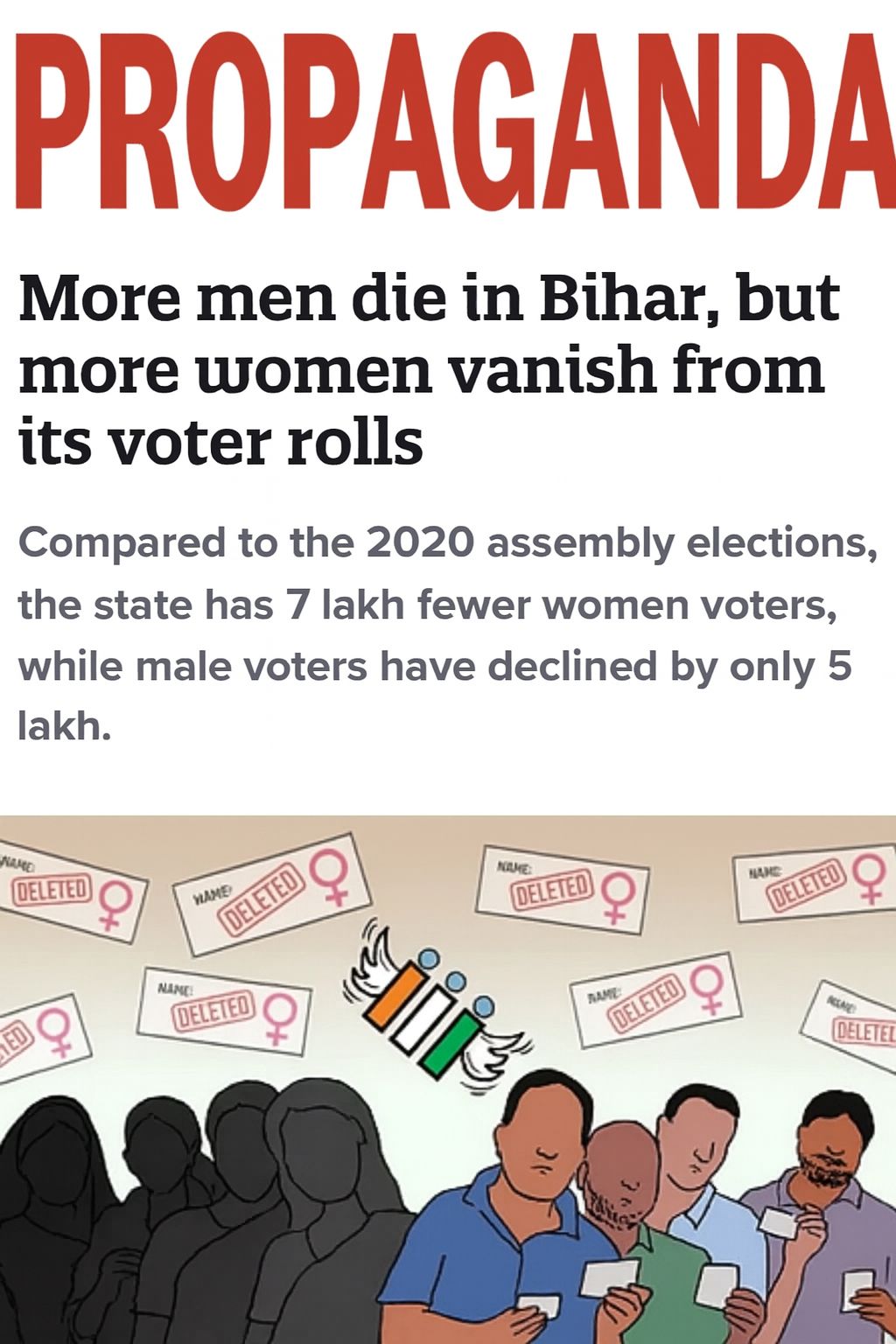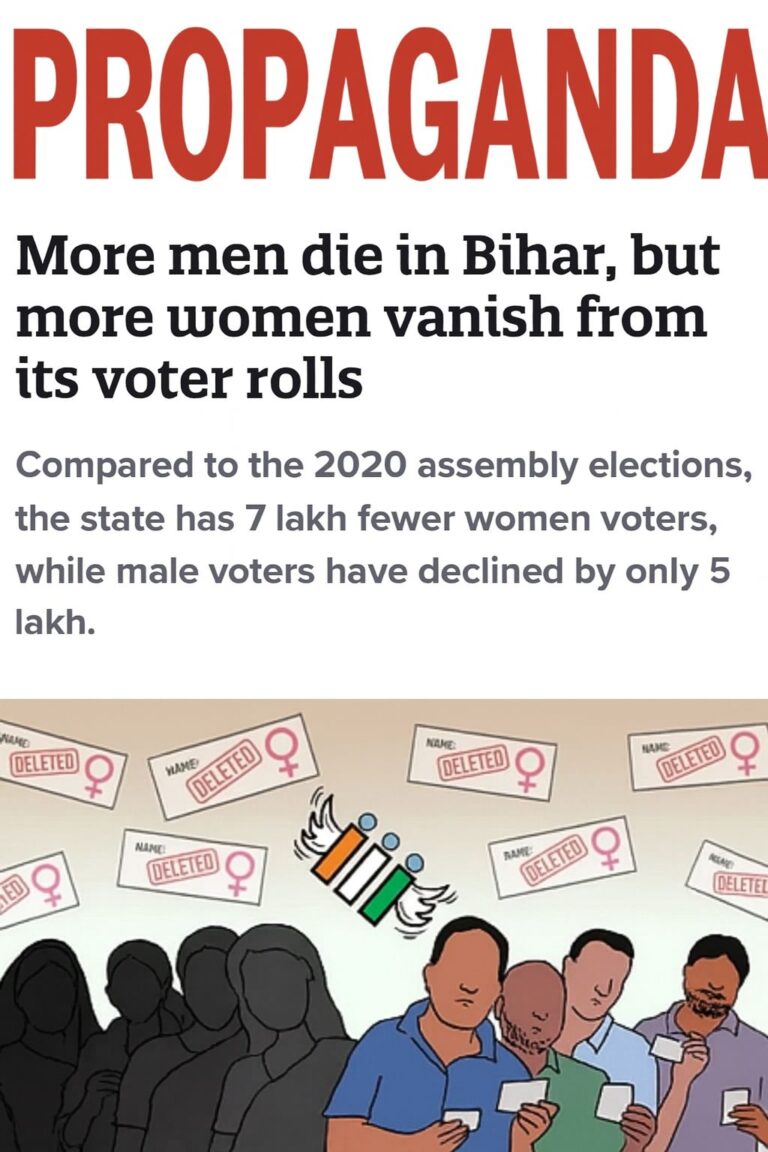
Oh, Newslaundry, you’ve done it again—spun a tale so juicy it could star in a Bollywood thriller. Their September 12, 2025, piece, *“More men die in Bihar, but more women vanish from its voter rolls,”* screams conspiracy, alleging the Election Commission of India (ECI) is mysteriously wiping women off Bihar’s voter lists while men bravely meet their maker. With a flair for drama, it claims that despite men accounting for nearly 60% of deaths from 2018–2022, 3.659 million women were deleted from voter rolls in the 2025 Special Intensive Revision (SIR) compared to 2.93 million men, with 1.16 million women marked “dead” versus 1.06 million men. Cue the ominous music: women’s voter turnout is up (from 42.51% in 2005 to 59.7% in 2020), yet gender ratios are down (from 913 to 892 women per 1,000 men), and Muslim-majority seats like Kochadhaman are hit hard! Sounds like a scandal, right? Wrong. This article is a masterclass in cherry-picking, ignoring hard data from ECI reports, Supreme Court filings, and basic Bihar demographics. Let’s tear it apart with facts and figures, exposing this narrative for the fearmongering fluff it is.
The “Death” Deception: Not a Conspiracy, Just Cleanup
The article’s big hook is the “paradox” of more women being deleted for “death” despite men dying more. Spooky! But the ECI’s SIR data, released post a Supreme Court order in August 2025, tells a different story. Of the 6.57 million total deletions (slightly varying from the 6.5 million reported elsewhere), women outpaced men in “death” deletions by a mere 100,000—a 9.4% gap. Hardly a feminist purge. The real story lies elsewhere: 1.609 million women were deleted for “permanently shifted” compared to 1.04 million men—a 55% difference. Why? Marriage-driven migration, a cultural norm in Bihar that Newslaundry barely nods at. The ECI flags “frequent migration” as a top SIR trigger, and Supreme Court hearings confirmed marriage as the leading cause of female relocation. Bihar’s sex ratio at birth was 891 girls per 1,000 boys in 2022 (Civil Registration System), and female literacy lags at 60.5% versus 79.7% for men (2023). Lower literacy means more women (520,000 vs. 440,000 men) failed to submit required enumeration forms, leading to “untraceable” deletions. The Hindu, which Newslaundry parrots, spells it out: “A plausible explanation is a gender gap in the submission of enumeration forms.” Newslaundry? Silent, preferring to hype district-level outliers like Buxar (60% of “death” deletions were women). But these are tiny fractions—Baniapur’s 6,677 female “death” deletions are just 0.05% of its voters. And Bihar’s crude death rate (5.5 per 1,000 rural in 2020) means annual deaths are ~7–8 lakh for a 13.1 crore population. Claiming 1.16 million female “deaths”? Ludicrous—those are ghost entries from outdated rolls, not bodies.
Gender Ratio Gimmick: Migration, Not Malice
Newslaundry wails about the post-SIR gender ratio dropping to 892:1,000, calling it the “lowest in five years.” Cue the violins! But pre-SIR, it was already a measly 913, down from 918 (2011 Census projections to 2025). The dip? Driven by migration deletions, not some anti-woman plot. In all 243 Bihar constituencies, more women under 40 were deleted for “shifting” than men—hello, marriage migration. The article spotlights Muslim-majority seats like Amour (ratio to 856:1,000), hinting at targeted disenfranchisement. But The Hindu’s analysis finds no clear evidence of Muslim-specific deletions; it’s more about migration-heavy districts (r ≈ 0.40 correlation). Patna, with 3.95 lakh deletions (1.26 lakh under 40, 67,011 shifted), tops the list because it’s urban and migrant-heavy—not a conspiracy. Opposition cries of “vote theft” admit the SIR tackled duplicates and ghosts from pre-2025 rolls, which were “robust” until the ECI’s June 2025 overhaul. Total electors post-SIR? ~7.24 crore, down 56 lakh from January—standard for a state with ~2.5 million annual migrant workers.
Transparency, Not Treachery
Here’s the kicker: Newslaundry paints the SIR as a shadowy scheme undermining women’s “decisive” turnout (50.4% in 2024 Lok Sabha, outpacing men). But the process was court-mandated for transparency. The Supreme Court ordered searchable deletion lists with reasons by August 19, 2025, accepting Aadhaar as proof, with booth-level officers displaying details. Aggrieved voters could file claims—91.69% submitted forms initially. No mass disenfranchisement; just sloppy verification hitting illiterate or migrant women harder, as The Hindu notes. Newslaundry’s nod to Nitish Kumar’s women-centric schemes (like Mukhiya Mantri Mahila Rozgar Yojana, offering Rs 10,000–200,000 for businesses) as ironic contrast is just filler. The “vanishing women” trope is pure clickbait.
The Real Scandal? Lazy Journalism
This article isn’t investigative journalism; it’s a sensationalist snooze-fest. Deletions reflect migration, literacy gaps, and routine roll hygiene—not a war on women. Bihar’s SIR ensures cleaner elections for 7.24 crore voters, where women still flex their electoral muscle. If Newslaundry wants a real scoop, try Bihar’s 84% rural households or 36% EBC population grappling with migration. But nah, “vanishing voters” sell better. Next time, ditch the drama and stick to the data.
Sources: ECI SIR data (2025), Supreme Court filings, The Hindu, Civil Registration System (2022), Registrar General (2020), 2011 Census projections.
Author : Sandeep Gandotra, is a serial entrepreneur, startup founder, social media influencer and political analyst with 25 years of overall experience. Tweets at Sandeep Gandotra





